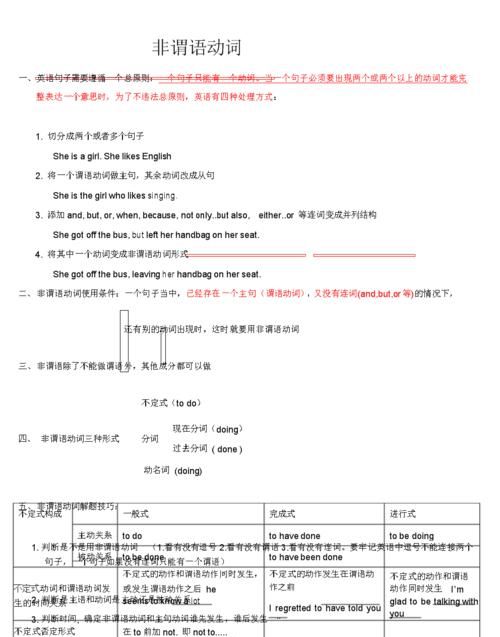本文目录
什么是动词不定式
我看前面答主的那些回答也是一知半解的。根本不能回答题主想要知道的。还在那里轴着。其实没有任何意义,是帮助不到题主的。
要了解动词不定式首先要了解动词,因为它是在动词这一大问题下面的一个小问题。
就好像我们要了解狮子为何是狮子,就要先了解猫科动物的由来!知道了这些,我们才知道,猫科动物是怎样演化成狮子的。
回到问题
动词就是我们中国人说话句子里的,坐,走,跑,跳,这些动作词。动词在英语里分两种,一种是谓语动词,一种是非谓语动词(!也叫动词不定式!),英语中最简单的一句话是主语、谓语、宾语三个结构组成的主.谓.宾结构,即我 I (主语),想want/想念Miss(谓语-动词),你you(宾)。即 I WANT YOU(此时这个句子里只有一个动词want)
以上英文一句话里出现一个动词
那么当我们用英文说一句话的时候里面出现两个动词时候。
即 I want hug you,这时就要注意了,注意什么呢,注意把第二个出现的动词变成动词不定式。如下。
我 I(主语),
想 Want(第一个动词-谓语-是动词本身,也叫动词原型。)
拥抱hug(第二个动词-非谓语,因为第二个出现所以要在前面加to变成动词不定式即to hug)
你you(宾语),
所以就是 I want to hug(第二个动词在前面+to变成to hug,也就是动词不定式) you.
不要纠结为什么第二个出现的动词要加to哈,这个是规矩,要问第一个定这个规矩的人,不过那个人早就go die了,所以没答案的哈,你只需要记住这个公式就行了,万年不变的铁律哈。

什么是动词不定式?
仅供参考:动词不定式:(to)+do,具有名词、形容词、副词的特征.
否定式:not + (to) do
(1)一般式:不定式的一般式所表示的动作与谓语动词动作同时发生或发生在谓语动词动作之后.
例如:
I'm glad to meet you.
He seems to know a lot.
We plan to pay a visit.
He wants to be an artist.
The patient asked to be operated on at once.
The teacher ordered the work to be done.
(2)进行式:不定式的进行式所表示的动作与谓语动词动作同时发生,例如:
The boy pretended to be working hard.
He seems to be reading in his room.
(3)完成式:不定式的完成式表示的动作发生在谓语动词动作之前,例如:
I regretted to have told a lie.
I happened to have seen the film.
He is pleased to have met his friend.
2.不定式的句法功能:
(1)作主语:
To finish the work in ten minutes is very hard.
To lose your heart means failure.
动词不定式短语作主语时,常用it作形式主语,真正的主语不定式置于句后,例如上面两句可用如下形式:
It is very hard to finish the work in ten minutes.
It means failure to lose your heart.
常用句式有:1、It+be+名词+to do。2、It takes sb.+some time+to do。3、It+be+形容词+of sb +to do。4、It+be+形容词+for sb.+to do。常用careless,,clever,good,foolish,honest,kind,lazy,nice,right,silly,stupid,wise,等表示赞扬或批评的形容词,不定式前的sb.可作其逻辑主语。
(2)作表语:
Her job is to clean the hall.
He appears to have caught a cold.
(3)作宾语:
常与不定式做宾语连用的动词有:want, hope, wish, offer, fail, plan, learn, pretend, refuse, manage, help, agree, promise, prefer, 如果不定式(宾语)后面有宾语补足语,则用it作形式宾语,真正的宾语(不定式)后置,放在宾语补足语后面,例如:
Marx found it important to study the situation in Russia.
动词不定式也可充当介词宾语,如:
I have no choice but to stay here.
He did nothing last Sunday but repair his bike.
动词不定式前有时可与疑问词连用,如:
He gave us some advice on how to learn English.
(4)作宾语补足语:
在复合宾语中,动词不定式可充当宾语补足语,如下动词常跟这种复合宾语:want, wish, ask, tell, order, beg, permit, help, advise, persuade, allow, prepare, cause, force, call on, wait for, invite.
此外,介词有时也与这种复合宾语连用,如:
With a lot of work to do, he didn't go to the cinema.
有些动词如make, let, see, watch, hear, feel, have等与不带有to的不定式连用,但改为被动语态时,不定式要加to, 如:
I saw him cross the road.
He was seen to cross the road.
(5)作定语:
动词不定式作定语,放在所修饰的名词或代词后。与所修饰名词有如下关系:
①动宾关系:
I have a meeting to attend.
注意:不定式为不及物动词时,所修饰的名词如果是地点、工具等,应有必要的介词,如:
He found a good house to live in.
The child has nothing to worry about.
What did you open it with?
如果不定式修饰time, place, way,可以省略介词:
He has no place to live.
This is the best way to work out this problem.
如果不定式所修饰名词是不定式动作承受者,不定式可用主动式也可用被动式:
Have you got anything to send?
Have you got anything to be sent?
②说明所修饰名词的内容:
We have made a plan to finish the work.
③被修饰名词是不定式逻辑主语:
He is the first to get here.
(6)作状语:
①表目的:
He worked day and night to get the money.
She sold her hair to buy the watch chain.
注意不定式放句首时,逻辑主语与句子主语要一致:
wrong:To save money, every means has been tried.
right:To save money, he has tried every means.
wrong:To learn English well, a dictionary is needed.
right:To learn English well, he needs a dictionary.
②表结果(往往是与预期愿望相反的结果):
He arrived late only to find the train had gone.
I visited him only to find him out.
③表原因:
They were very sad to hear the news.
④表程度:
It's too dark for us to see anything.
The question is simple for him to answer.
(7)作独立成分:
To tell you the truth, I don't like the way he talked.
(8)不定式的省略:保留to省略do动词。
If you don't want to do it, you don't need to.
(9)不定式的并列:第二个不定式可省略to。
He wished to study medicine and become a doctor.

动词不定式是什么意思
动词不定式是一种非限定性动词,由to+动词原形构成,但在有些情况下to可以省略(注意:在被动语态中则to 不能省掉)。如:
主动形式 被动形式
一般式 (not) to make (not) to be made
完成式 (not) to have made (not) to have been made
进行式 (not) to be making
完成进行式 (not) to have been making
(1)语态
如果动词不定式的逻辑主语是这个不定式所表示的动作的承受者,不定式一般要用被动语态形式。如:
It's a great honour to be invited to Mary's birthday party.(不定式作主语)
It was impossible for lost time to be made up.(不定式作主语)
I wish to be sent to work in the country.(不定式作宾语)
Can you tell me which is the car to be repaired?(不定式作定语)
He went to the hospital to be examined.(不定式作状语)
在There be结构中,修饰主语的不定式可用被动,也可用主动。如:There are still many things to t ake care of (to be taken care of).但有时两种形式表达的意思不同,如:These is nothing to do now.( We have nothing to do now.) There is nothing to be done now.(We can do nothing now.)
(2)时态
1) 现在时:一般现在时表示的动词,有时与谓语动词表示的动作同时发生,有时发生在谓语动词的动作之后。
He seems to know this.
I hope to see you again. = I hope that I'll see you again. 我希望再见到你。
2) 完成时:表示的动作发生在谓语动词表示的动作之前。
I'm sorry to have given you so much trouble.
He seems to have caught a cold.
3) 进行时: 表示动作正在进行,与谓语动词表示的动作同时发生。
He seems to be eating something.
4) 完成进行时:
She is known to have been wreaking on the problem for many years.
注意:在被动语态中则to 不能省掉

怎样理解动词不定式和动名词
动词不定式的简介
[编辑本段]
动词不定式是一种非限定性动词,由to+动词原形构成,但在有些情况下to可以省略。它还是属于动词,本身可以带宾语和状语。我是抄的动词不定式在句中可以作主语、宾语、表语、定语和状语,还可用在复合结构中,而且有完成式、进行式、完成进行式和否定形式。动词不定式的被动形式除了一般形式外还有其完成式和进行式。
动词不定式的时态、语态
[编辑本段]
动词不定式可以作以上各种成分,但它毕竟是动词,所以有动词的属性
动词不定式及其短语还可以有自己的宾语、状语,虽然动词不定式在语法上没有表面上的直接主语,但它表达的意义是动作,这一动作一定由使动者发出。这一使动者我们称之为 逻辑主语,其形式如下:
主动形式 被动形式
一般式 (not) to make (not) to be made
完成式 (not) to have made (not) to have been made
进行式 (not) to be making
完成进行式 (not) to have been making
(1)语态
如果动词不定式的逻辑主语是这个不定式所表示的动作的承受者,不定式一般要用被动语态形式。如:
It's a great honour to be invited to Mary's birthday party.(不定式作主语)
It was impossible for lost time to be made up.(不定式作主语)
I wish to be sent to work in the country.(不定式作宾语)
Can you tell me which is the car to be repaired?(不定式作定语)
He went to the hospital to be examined.(不定式作状语)
在There be结构中,修饰主语的不定式可用被动,也可用主动。如:There are still many things to t ake care of (to be taken care of).但有时两种形式表达的意思不同,如:These is nothing to do now.( We have nothing to do now.) There is nothing to be done now.(We can do nothing now.)
(2)时态
1) 现在时:一般现在时表示的动词,有时与谓语动词表示的动作同时发生,有时发生在谓语动词的动作之后。
He seems to know this.
I hope to see you again. = I hope that I'll see you again. 我希望再见到你。
2) 完成时:表示的动作发生在谓语动词表示的动作之前。
I'm sorry to have given you so much trouble.
He seems to have caught a cold.
3) 进行时: 表示动作正在进行,与谓语动词表示的动作同时发生。
He seems to be eating something.
4) 完成进行时:
She is known to have been wreaking on the problem for many years.
疑问词+不定式结构
[编辑本段]
疑问词who,what,which,when,where,whether,how后可接不定式构成不定式短语,在句中作主语、宾语、表 语等。如:
①When to leave for London has not been decided yet. (不定式在句子中做主语)
②Mr. Smith didn't know whether to leave or stay there. (不定式在句子中做宾语)
③I asked Professor Xu how to learn English well. (不定式在句子中做间接宾语)
④The question was where to get the medicine needed. (不定式在句子中表语)
以上例句中疑问词+不定式部分,均可转换为相应的从句形式。如:①When we shall leave…③…how I
could learn…
经常在这种结构中使用的动词有:consider,decide,discover,explain,find out,forget,hear,know,lea rn,observe,understand,wonder等。

以上就是关于到底该怎样理解动词不定式 ,什么是动词不定式的全部内容,以及到底该怎样理解动词不定式 的相关内容,希望能够帮到您。

